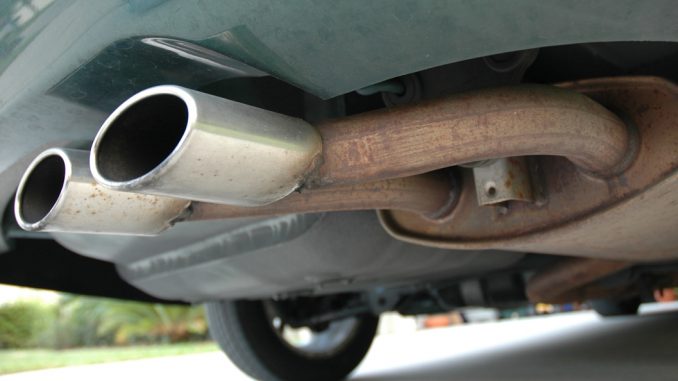
A car exhaust pipe is just like any other pipe and that means that when you need to fix a leak on a broken car exhaust system, it can be done as easily as a water pipe repair in your home.
The only difference really is temperature. A car exhaust pipe is subjected to much higher temperatures than most pipes in the home. What this means is that you need to find repair materials capable of handling such extremes, which to be honest is very easy.
Here is how to fix a broken exhaust pipe without a mechanic.
Wait for the exhaust pipe to cool
As already noted, exhaust pipes get very hot when they are in use. After even the shortest journey, the system can take a long time to cool down sufficiently to be worked on.
After the car has been parked with the engine off for a couple of hours, place your hand near to the exhaust pipe. If it is still radiating heat, then continue to let it cool. Touching the bonnet of the car can also tell you if the engine is still warm and by association, the exhaust pipe.
When the exhaust pipe is giving off no heat, then you are safe to begin the repair.
Jack the vehicle requiring an exhaust pipe leak repair
To locate a leak in an exhaust system and carry out the necessary repair, the vehicle first needs to be jacked so that the pipe can be inspected.
Vehicles should always be jacked up on hard, flat surfaces which can support the weight. Once the vehicle has been jacked high enough to inspect the exhaust pipe, place jack stands beneath it. Work should never be carried out underneath a vehicle without jack stands in place.
Inspect the exhaust pipe
Once you have jacked the vehicle then you can inspect the exhaust pipe for the hole or crack causing the leak. The problem may not be obvious straight away, in which case pay close attention to areas of rust or surface damage to the pipe.
Scrapes can be an indication of where the pipe has hit the road, causing punctures. Rust meanwhile can cause leaks to appear through weakening the metal of the exhaust pipe.
If you still cannot find the leak, then turn the engine on and inspect again. A crack in the exhaust pipe should now become more visually obvious with gasses escaping from the damage area.
Decide on your repair method
There are two methods for fixing an exhaust pipe leak – pipe repair tape or epoxy putty. A silicone repair tape like Wrap & Seal will self-fuse over the hole in the pipe, forming a solid rubber band to seal the leak.
Repairs made with Wrap & Seal are temperature resistant to 200°C, making it more than capable of handling an exhaust pipe. The one downside to using a tape can be in the application.
If space is tight around the exhaust pipe, then it may not be possible to wrap the tape effectively. Wrap & Seal for example fuses most effectively when stretched to three times its length. If there is little to no room for manoeuvre between the car and the exhaust, then it can be difficult to achieve.
In which case, you would use an epoxy putty. There are many different epoxy putty formulations, some for certain materials and others with specific cure times.
For an exhaust pipe repair, a high-temperature epoxy putty such as Superfast Titanium Stick would be required to handle the heat of the system.
Preparing the exhaust pipe for repair
Unlike a copper pipe repair or PVC plastic pipe repair where epoxy putty or tape can be applied direct, a degree of preparation is usually needed with an exhaust pipe because of the environment it operates in.
Dirt, debris and rust stuck to the pipe will impact on the effectiveness of the repair. Sandpaper should be used to remove as much of these foreign objects as possible. For exhaust pipes suffering heavy surface damage, acetone will clean the pipe further.
If you do not want to go out and buy acetone strictly for preparing a small section of exhaust pipe, then you can use nail varnish remover as acetone is its main ingredient.
Making an exhaust pipe repair with pipe repair tape
Anchor the pipe repair tape to one side of the hole or crack in the exhaust. Stretch the tape as much as possible and then wrap across the leak.
As you wrap, the silicone tape will begin to fuse, sealing the hole or crack in the pipe. You should use the full length of tape to ensure a long-lasting, high-pressure repair.
Fixing an exhaust pipe leak with epoxy putty
Epoxy putty is made up of two separate components, part A and part B. Both parts are soft until mixed together, when a chemical reaction takes place to create a material which cures to be harder than steel.
Some putties will supply the two parts completely separately, leaving it to the user to mix in the correct ratios. Others come in a pre-formatted stick to make application easier, including Superfast Titanium. With a stick, you simply cut off the amount of putty required and knead it by hand.
Once you begin to mix the putty, it will turn to a uniform colour and begin to cure. Whilst soft, it is pushed into the hole or crack in the exhaust pipe where it will harden and seal the leak.
An exhaust pipe leak repair using epoxy putty can be completed in under 15 minutes depending on the work time of the putty. The cure time of the putty will determine how long it must be allowed to set for a full repair to be completed before the vehicle can be used again.

Leave a Reply